Record levels of consumer confidence boosted Christmas sales. Personal consumption expenditures, which account for two-thirds of the economy, increased by 5.3 percent, after inflation, for both the fourth quarter and 1999 as a whole. [Table 1a shows the growth in the major components of real GDP.]
Business investment was up 8.4 percent over the third quarter, thanks to a 72 percent increase in inventories. A potential trouble spot was fixed investment which increased by only 1.6 percent in the fourth quarter compared to 6.8 percent in the third. Two-thirds of the slowdown occurred in transportation equipment, a likely result of higher oil prices, and the rest in computers and communication equipment probably related to Y2K.
The federal government went on a spending spree in the fourth quarter. Defense purchases increased by 18.9 percent and nondefense by 11.1 percent. Combined with the more restrained 4.4 percent rise in states and localities, government purchases increased by 8.4 percent over the third quarter. For 1999 as a whole, government purchases almost kept pace with economic growth.
The gap between exports and imports widened in the fourth quarter. While American goods sold overseas increased by 6.8 percent, foreign goods purchased at home jumped by 10.6 percent. For all of 1999, the current account deficit stood at $324.5 billion compared to $215.1 billion in 1998.
Based just on the two stalwarts of growth—consumption and fixed private investment—the economy advanced by 4.5 percent in the fourth quarter. The build up in inventories and the jump in government spending raised the growth rate to 6.3 percent while the trade deficit knocked it back down to 5.8 percent. [See Table 1b.]
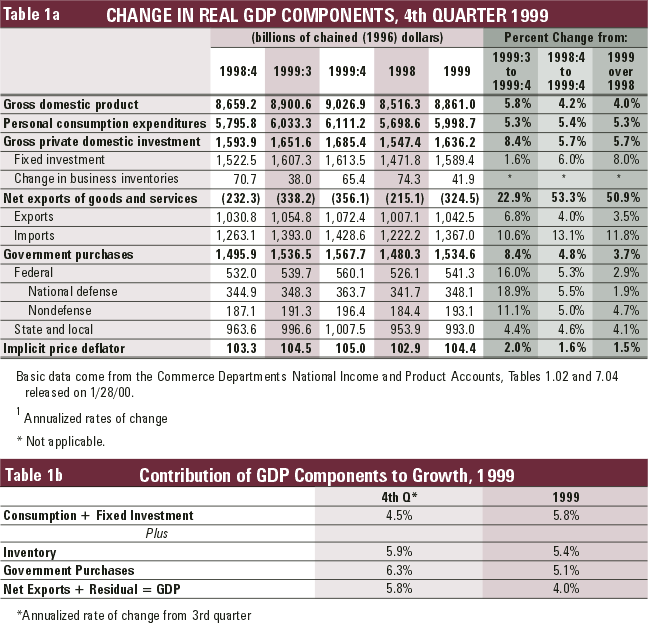
Putting somewhat of a damper on this strong performance was a 2 percent increase in the GDP price deflator. That, along with rises in the closely-watched Employment Cost Index and the prices-paid component of the Purchasing Manager’s Index re-ignited concerns over inflation, prompting the Federal Reserve to raise interest rates by 25 basis points at its February meeting.
Economic Recovery Now Longest in History
Lingering worries over inflation and whether the Federal Reserve has more interest-rate hikes in store aside, the economic recovery which began in March 1991 is now the longest in history. Although official confirmation won’t come until the Commerce Department reports on first-quarter GDP at the end of April, the sheer momentum with which the economy finished 1999, along with the 387,000 jobs added in January, assures at least one more quarter of positive growth. That means February marks the 107th month of economic expansion, surpassing the 1960s boom which lasted from February 1961 through December 1969.
But can the current expansion last much longer? Are there parallels between the late 1960s and today? To help answer these questions, this issue of the Economic Scorecard compares the performance of a number of economic indicators during the two recoveries.
Real GDP
Because the strongest growth has come later rather than sooner, the current recovery has not been able to take full advantage of compounding. As a result, real GDP today is 36.4 percent higher than in March 1991 where the advance during the 1960s reached over 50 percent. [See Figure 1 and Table 2.]
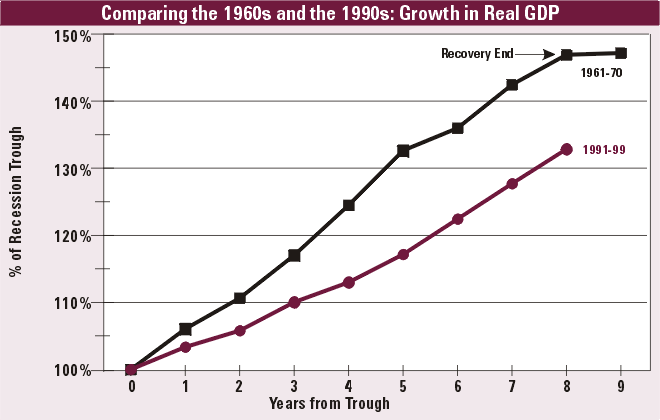
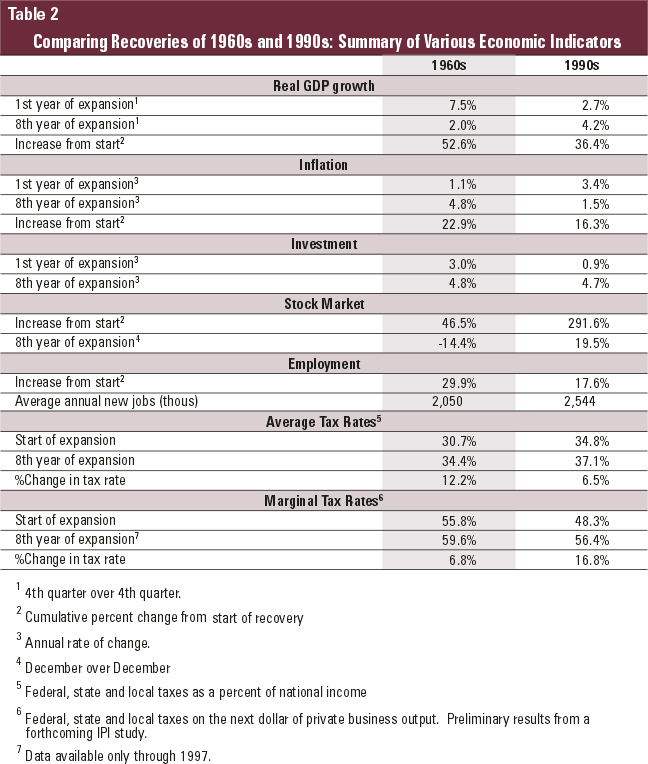
Inflation
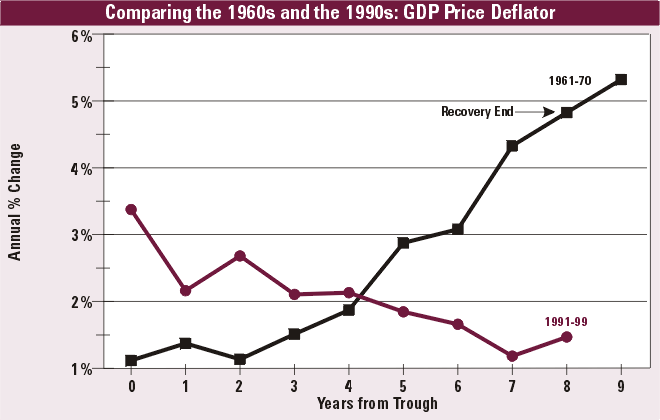
These results fly in the face of conventional wisdom which holds that strong growth inevitably leads to higher inflation. In both cases, periods of strongest growth were associated with lower inflation and periods of weakest growth were associated with higher inflation.
Investment
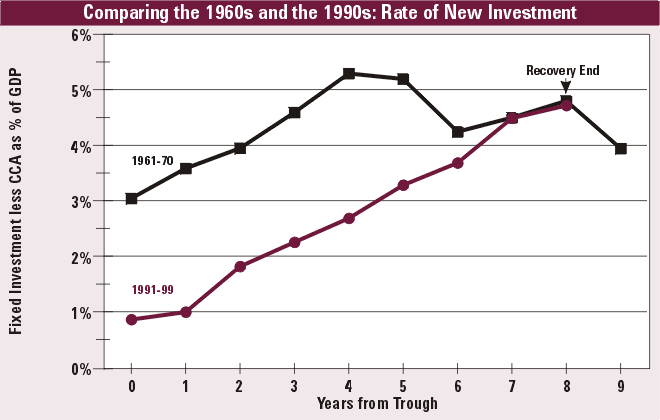
While starting out considerably below the 1960s, the rate of new investment during the current expansion continues to accelerate, rising from 0.9 percent in 1991 to 4.7 percent last year. This strength in investment means that this expansion most likely is not yet ready to end.
Stock Market
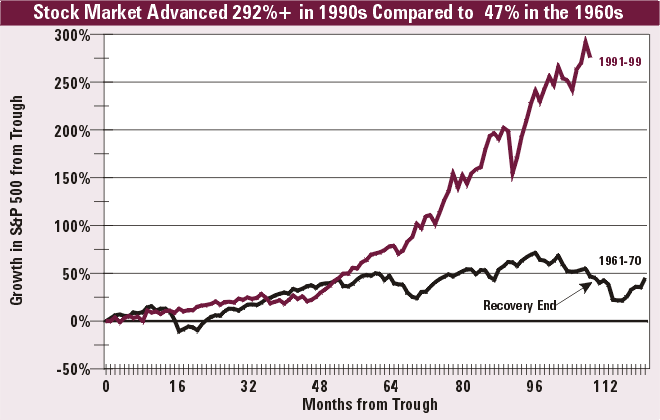
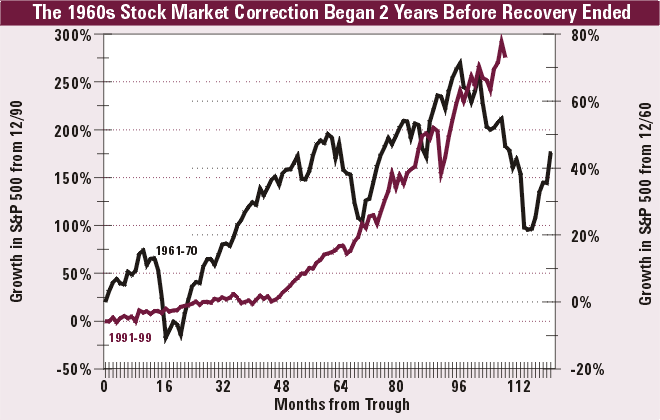
Concerns over excess speculation may be valid, especially in view of the market’s spectacular growth the past few years. The 345 percent increase in the S&P 500 during the 1990s beats the 60 percent advance of the 1960s five times over. But what is not yet in evidence is a prolonged market correction like the one that started a year before the 1960s expansion came to an end. Like investment, the stock market is a leading economic indicator. Asset prices usually head south well before the economy shows other visible signs of slowing. As long as the stock market continues to move higher, the current expansion should continue.
Jobs
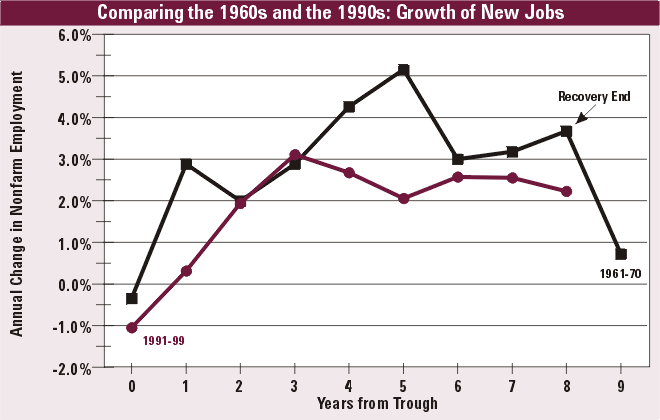
Tax Rates
While marginal tax rates were lower at the start of the recovery, they too are trending higher. In 1997, federal, state and local taxes claimed 56.4 cents out of the next dollar of output produced by private businesses, up from 48.3 cents in 1991.
One of the factors that led to the demise of the 1960s recovery was the surtax put on in 1968 to help fight two wars—Vietnam and poverty. The resulting increases in average and marginal tax rates coupled with loose monetary policy helped end the boom of the 1960s and laid the groundwork for stagflation. Likewise, ever-higher tax rates could just as easily squeeze off the current expansion. [See Figures 7 and 8 and Table 2.]
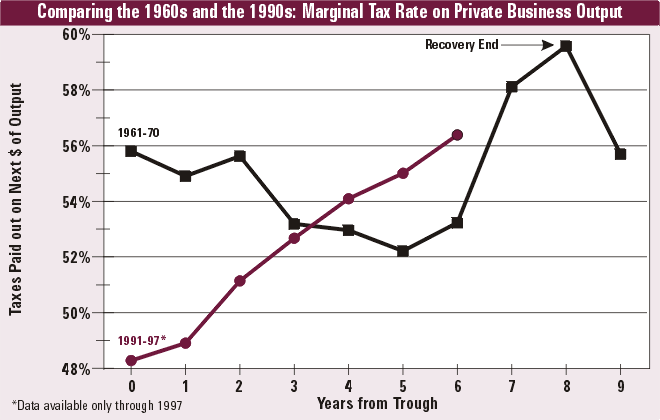
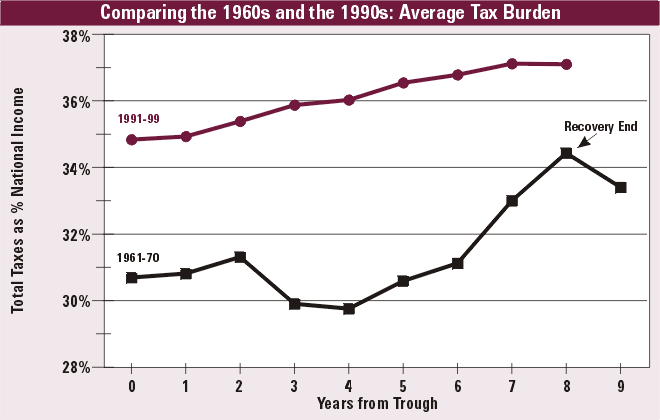
In sum, from the evidence presented here, the longest expansion in history still seems to be going strong. Productivity gains from robust investment, particularly in computers and other information-age technology, have kept corporate profits growing and made non-inflationary wage gains possible, even in supposedly tight labor markets. All of these factors have helped fuel the stock market.
But, the weak performance of fixed investment in the fourth quarter noted earlier and the choppy start of the year for the stock market (the S&P 500 finished January down 5 percent) bear close watching. Persistent weakness in these leading economic indicators would mean that businesses no longer wish to expand in the U.S. Rising marginal tax rates is the one factor reducing U.S. attractiveness as a place to invest. The best way to avert a premature end to the recovery would be to cut taxes on saving and investment.
CBO Ups Its Forecast of Federal Surpluses
Thanks largely to a booming economy, the federal government’s black ink keeps mounting. In its January Budget and Economic Outlook, the Congressional Budget Office (CBO) forecasts budget surpluses mounting to almost $3.8 trillion between 2000 and 2009. That is 30 percent higher than July’s forecast of $2.9 trillion and 47 percent higher than last January’s. Three-fourths of the difference is due to an upward revision in forecasts of federal tax revenues. [See Figure 9.]
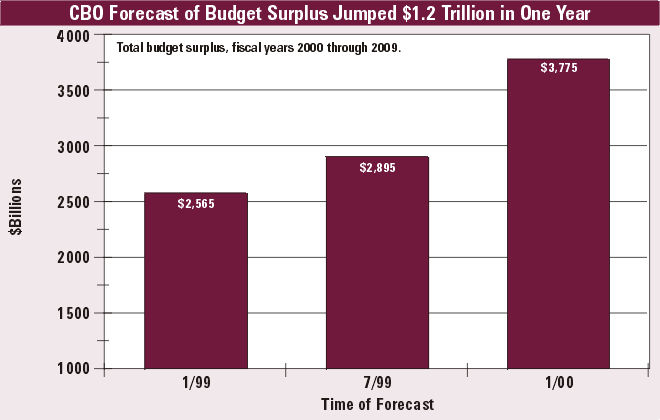
Conclusions
In February, the expansion that began in March 1991 entered its 107th month, surpassing that of the 1960s to become the longest in history. A healthy rate of investment, particularly in technology, low inflation and high productivity have been the driving forces behind a recovery whose persistence and strength has repeatedly surprised forecasters and analysts. But the economic good times should not lull the public and policy makers into complacency. What must be remembered is that, just as in the 1960s, higher inflation from wrong-headed monetary policy or ever-increasing marginal tax rates that lower returns to workers and investors could again bring the now-longest expansion abruptly to an end.
